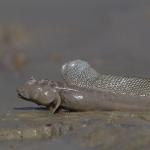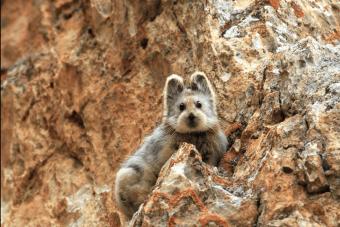Shiitake is one of the most popular artificially cultivated mushrooms. It is especially loved in the countries of Southeast Asia and, above all, in Japan and China. This mushroom is very loved not only by gourmets for its excellent taste, but also by mushroom growers for its high yield and relative ease of cultivation. In Russia, shiitake is also known, but is inferior in popularity to champignons and oyster mushrooms. In other words, the competition among its producers in our country is not yet very high.
Shiitake mushroom (more correct transcription - shiitake) is also known as Japanese forest mushroom and edible lentinula.
Shiitake has a medium size: a hat from five to twenty centimeters in diameter, has a brown or coffee color. The cap is convex or slightly flattened. The outer skin is dotted with small light scales. In old mushrooms, the edges of the cap are uneven and bent.
On the underside, the cap is covered with white plates, which darken when damaged, taking on a brown tint. The stem is also brown, but always noticeably lighter than the cap. Its length ranges from three to nineteen centimeters with an average diameter of about a centimeter.
The flesh has a light cream or yellow-whitish tint, as well as a pleasant taste (even when raw) and smell. In the cap the flesh is fleshy, in the stem it is much more rigid and fibrous.
In their natural environment, Japanese shiitake are found in deciduous and mixed forests in Japan, Korea, northern China and Russian Primorye. These are typical saprotrophs that live on dead tree trunks, especially preferring spiky castanopsis, Mongolian oak and Amur linden. Small groups of shiitake appear after rains throughout the warm season.
On the territory of the Russian Federation, shiitake is found only in Primorye, therefore, outside of this region, it is useless to look for it in principle. In Primorye itself, only three types of mushrooms grow, which theoretically can be confused with shiitake. We are talking about mushrooms of the genus champignon - dark red, forest and August. They have a similar color scheme and scales on their hats.
An experienced mushroom picker will never confuse shiitake with champignons, if only because the Japanese forest mushroom grows only on dead wood, and the mentioned champignons grow on the ground. They also differ in terms of fruiting. Mushrooms appear in summer and autumn, and shiitake is available for harvest in the spring.
However, even if a novice mushroom picker still confuses shiitake with champignons, big trouble will not come of it, since all these mushrooms are edible.
The Japanese forest mushroom is deservedly considered the leader in taste characteristics among all artificially cultivated mushrooms. In terms of taste, it is often compared even with boletus. In Korean, Chinese and Japanese cuisine, shiitake is almost the main mushroom.
The Japanese mushroom shows itself perfectly in any mushroom dishes and lends itself to all types of cooking. In Asian cuisines, it is also very common to make dried shiitake powder and then use it in soups. Dried shiitake retains its natural aroma surprisingly well, so as an aromatic condiment it is just great. However, when dried, these mushrooms noticeably lose their taste, so many Japanese gourmets prefer them only fresh.
It should be noted that shiitake has a slightly spicy taste, and this often scares off Europeans who are not used to such a thing. But during heat treatment, a significant part of this sharpness disappears, so the taste of shiitake cannot be considered quite exotic.
These mushrooms have found no less widespread use in folk and modern medicine. For centuries, they have been used as an anti-aging agent, which, among other things, strengthens male potency. Shiitake was also used directly for medicinal purposes: to lower the temperature during a fever and to cleanse the blood of toxins.
In the modern world, it is also widely used for medical purposes. With its help, they fight against viral infections, diseases of the heart and stomach. In addition, shiitake helps to lower blood sugar levels and break down cholesterol in blood vessels.
The great benefit of shiitake manifests itself in cosmetology medicine, where it is used to make products to combat certain skin diseases.
Growing shiitake at home
The Japanese and Chinese grow shiitake on logs, which to a certain extent makes this technique related to growing oyster mushrooms. But there are significant differences here. Firstly, shiitake mycelium grows much more slowly than oyster mushroom, which makes it difficult to control mold that competes with mycelium.
Secondly, the fruiting of oyster mushrooms is provoked by a decrease in temperature, which should imitate the arrival of autumn, and shiitake begins to bear fruit after watering the "bed", which imitates the rainy season. Thus, while growing shiitake requires precise cultivation, it is easier to grow at home than oyster mushrooms, which require a climate control system.
There are two approaches to growing shiitake - intensive (industrial) and amateur. The industrial method can significantly reduce the ripening time of the crop and provides for the heat treatment of the sawdust substrate. Fruiting at the same time goes all year in a room with a controlled temperature.
With the amateur method, mushroom growers try to follow the general outline of the industrial method, but using improvised materials and forcedly neglecting sterility at some stages.
The basis for the nutrient substrate is formed from oak, maple or beech sawdust. Also allowed are alder, birch, poplar, aspen sawdust, in exceptional cases, other types of trees. Coniferous trees are completely unsuitable for growing shiitake mushrooms.
You should also pay attention to the size of sawdust: optimally two to three millimeters. Smaller sawdust makes it difficult to exchange air in the substrate, which slows down the development of the fungus. But too large sawdust should not be taken either, since an increase in the oxygen content turns the substrate into a favorable environment for the development of competitive organisms.
To accelerate the growth of mycelium and increase productivity, sawdust is diluted with nutritional supplements. This role is usually taken from grain or bran of wheat and barley, bean flour, or other organic waste of this type. Gypsum or chalk is also mixed into the substrate to maintain optimal acidity in it. In general, all these additives can account for from 10 to 40% of the volume of the substrate.
After adding all the additional components to the sawdust, the substrate is thoroughly mixed and then water is added to ensure that the moisture content of the nutrient medium is not lower than 55%. However, the main difficulty is to create optimal conditions for growing shiitake, while preventing the development of mold and other competitive organisms in the substrate. To combat them, before inoculation of the mycelium, the substrate is sterilized or pasteurized. Only after that, the mycelium is placed in the disinfected and cooled mixture.
Typically, the substrate is sterilized using autoclaves, having previously packed it in bags. But there are alternative methods, when the substrate is first sterilized in its entirety, allowed to cool, inoculated, and only then placed in bags. True, in this case, everything will have to be done under sterile conditions, which will require additional costs.
Speaking of bags. It is best to use dense plastic bags with a volume of one to six liters. After placing the inoculated mycelium in them, they are closed and sealed with a stopper of cotton wool and gauze, through which air will circulate.
Inoculation, that is, seeding of mycelium, must be carried out only in a sterile substrate and only in a special sterile box in order to avoid entering into the substrate of competitive organisms that develop faster than shiitake mycelium. It is important that the temperature of the substrate at the time of inoculation is not less than 20 and not more than 30 degrees Celsius.
The properties of the shiitake mushroom are such that it is better to germinate the mycelium in wheat or barley grain. By the time of inoculation, this planting material is a tightly stuck together blocks. For this reason, grain blocks must be crushed back into individual grains before inoculation. The seeding rate of grains infected with mycelium is from two to five percent of the total mass of the substrate.
After sowing, the mycelium develops in a room with room temperature for 6-10 weeks, after which the substrate formed into dense lumps and overgrown with mycelium is removed from polyethylene, transferred to a cooler and more humid room, where it is left in such a “naked” form. Harvest from these blocks is obtained for three to six months.
amateur technology
Since growing shiitake mushroom at home, it is impossible to achieve complete sterility, the effectiveness of amateur technology is much lower than industrial technology.
The substrate is made using the same sawdust or hardwood shavings. It is also recommended to use standard types of additives, since it is not difficult to obtain them. The substrate mixture should be packaged in agril bags. Agril is a special "breathable" material designed to cover the beds in the garden.
Then these bags should be placed in hot water for 10-15 minutes, after which pasteurization is performed: at a temperature of 60 degrees, the mixture is kept for about a day and another three days at 50 degrees. After the substrate has cooled, it is removed from the bags and placed in sterilized 3-liter jars, having previously been inoculated with mycelium. Banks are sealed with a cotton plug.
Banks with inoculated substrate are left to overgrow with mycelium at a temperature of from seventeen to twenty-two degrees for two months. After that, the mixture must be removed from the jars again and returned to breathable bags, leaving it like that for another two weeks. During this time, the mycelium will form a dense block from the substrate, which must be soaked in water for several hours (up to a day). After that, after two weeks, the first mushrooms should appear.
Shiitake are quite picky when it comes to the conditions of existence - therefore, mycologists have learned to grow these mushrooms artificially and on an industrial scale. Mushrooms fruit continuously from about May to October. Of course, the cultivation of these mushrooms has its own subtleties associated with imitation of the natural conditions of the natural habitat of shiitake. But despite this, the technology for growing shiitake is not so complicated, and the mushroom may well be grown not only in central Russia, but also in any home conditions suitable for it. This is a laborious task, since the mycelium of the fungus grows slowly and in the process of growth needs additional feeding, protection from bacteria, but in 3-6 months you can achieve quite a decent harvest.
Substrate for shiitake: preparation and varieties
The substrate is the nutrient base on which the mushrooms will grow. The first thing you need to grow shiitake mushrooms is the right wood. Suitable trunks of beech, oak, chestnut or, for example, hornbeam. It is better to harvest stumps for their subsequent settlement with a mushroom colony at the beginning of spring, when the leaves have not yet begun to germinate and the level of natural sugars in the wood is the highest. The tree must be healthy, without obvious bark defects and not affected by other crops (tinder or lichen).
About a week before planting your mushroom plantation, dry wood should be sawn into 30-40 cm long bars and soaked in water or boiled for an hour. The main thing is that at the time of sowing mushrooms on it, the moisture content of the tree should be at least 15, but not more than 70%. In order for the wood not to dry out, it can be wrapped with polyethylene. The temperature in the room where the mushroom colonies will grow should be approximately + 16 ° C, while the mushrooms prefer a noticeable change in temperature day and night (but the temperature at night should not be lower than + 10 ° C).
In the bar, it is necessary to drill a series of small holes at the same distance (about 10 cm) from each other - about 10 mm in diameter and 6 cm deep. Shiitake mycelium (mycelium) is poured into these holes. Then the holes are closed with cotton wool moistened with clean water.
The process of populating a tree with mycelium is otherwise called inoculation.
If the mushrooms will be grown in the garden, then it is worth choosing a shaded area, and bury the stumps with mycelium by two thirds in the ground so that the tree does not dry out. Mushrooms can live on stumps for several years, until the wood is completely depleted and decays into dust.

The technology of growing shiitake on sawdust
If it is not possible to grow shiitake on the bars, then another method will come to the rescue - mushrooms can be grown on sawdust. To harvest one mushroom block with a volume of 2.5 liters, about 1 kg of wood is required. In order to increase the nutritional value of the habitat of the mushroom colony, bran, pomace remaining during the manufacture of beer, cereal grains are added to the sawdust. A block of such enriched sawdust is not perennial, the entire period from inoculation to the completion of fruiting takes up to 6 months.
When choosing a substrate, one should not take sawdust from coniferous trees as a basis; the high resin content in their wood prevents the growth and reproduction of mycelium. Sawdust for growing shiitake should not be too small - this will make it difficult for the mushrooms to get air.
The collected sawdust is subjected to heat treatment to avoid colonization of the substrate by other fungi and bacteria. To do this, it is enough to keep the sawdust in boiling water for an hour.
To introduce the mycelium, it is simply poured into a container with a ready-made substrate, covered with plastic wrap and left for several days. The optimum temperature, which will greatly facilitate the process of colonization by fungi, will be 20 ° C. In the future, when the mycelium germinate and begin to bear fruit, it can be reduced to 16-17°C during the day and 12-14°C at night. As the mycelium grows, the substrate changes color, when the mushrooms have finally sprouted in the new territory, the substrate becomes white.

Shiitake can be grown on sawdust
The technology of growing mushrooms on straw
Some use barley or oat straw as a substrate for shiitake. The technology for growing mushrooms on straw is not too different from the above methods, such as growing on stumps. Straw is also subjected to sterilization in boiling water for up to 2 hours to avoid damage by other colonies of fungi or bacteria. So that the straw does not boil soft, it must be placed in a cloth bag.
After the sterilized substrate has cooled down, it is mixed with mycelium in the proportion of 30-50 g of planting material per bag. It is better to fill the bag in layers - a layer of straw, then a mycelium, another layer of straw, and so on. From one straw block in the future, you can expect up to three waves of harvest.

The resulting mixture is distributed in plastic bags in the amount of 3-5 kg per bag, a number of holes are made in the polyethylene for ventilation, and the bag with mycelium is placed in a container with water. It will be better if the bag is pressed down with a press (a couple of ordinary bricks or ceramic tiles will do) so that the substrate is constantly in the water. The process of colonization and germination of fungi in a straw substrate lasts up to two weeks. After this period, when the colonization of fungi is completed, two-thirds of the bag must be freed from the film. It is necessary to moisten the straw as needed so that the mushroom colony does not dry out.
Shiitake cultivation can take place almost anywhere as long as the right temperature is maintained. A shed, a summer kitchen, a lawn in the garden with mushroom stumps, a forest clearing…
Mushrooms grow quite slowly compared to other similar mushroom crops like oyster mushrooms, but at the same time they are unpretentious, because in the homeland of shiitake, in Central Asia, the period of its intensive growth coincides with the rainy season. Immediately before harvesting (if mushrooms grow indoors), it is better to reduce the humidity level to 60%. Thanks to this procedure, the film on the surface of the mushrooms will become denser and tougher, which will allow you to collect the mushrooms without damaging them.
At the time of inoculation, shiitake are susceptible to infections in the form of competing bacteria, but a well-sterilized substrate will save you from this problem. Too high humidity can negatively affect the quality of the crop, so growing shiitake mushrooms indoors, where external environmental factors are easier to control, is still the best option.
Shiitake can be used to make many tasty and healthy dishes. Due to its value in many countries, the development of shiitake cultivation technologies has already acquired the nature of stream production. And if you decide to start growing mushrooms on your own, then it will not be difficult to buy shiitake mycelium of different varieties - many mushroom farms and online stores sell it, usually in the form of pressed sticks.
After ten years of growing shiitake on pieces of wood, I decided to try to get mushrooms on a sawdust substrate using the so-called industrial or intensive technology. It is faster: mushrooms do not appear in a year, but two months after the introduction of mycelium.

Moreover, such blocks can be placed in any room suitable for this, even on the windowsill in an apartment or in a country house under a canopy. And grow mushrooms - at any time of the year!
Making blocks for shiitake
To make blocks, I take 4 parts of fresh sawdust (oak, birch, alder), add 1 part of wheat bran (to feed the mycelium), 1% of the weight of the entire gypsum mixture (to improve the structure of the substrate and the desired acidity) and spill everything with water in volume equal to the weight of the dry mixture. Thoroughly mix and package, without compacting, in plastic bags of 600-700 g each. I put on sterilization for 3 hours at a temperature of + 98 ... + 100 degrees.
I do it this way: I lower the grate into a large saucepan, pour water to its level, put loose bags with the substrate on the grate, cover with a lid (I mounted a thermometer in it) and turn on a small fire. The resulting steam disinfects the sawdust. After that, I turn off the fire and let the sawdust cool (I do not remove the lid). A day later, I repeat the procedure again.
How to populate shiitake mycelium?
I populate the blocks with mycelium (I take grain mycelium) under sterile conditions in my home “micro-laboratory”. I made a sealed pencil case with glass on the top cover, a bactericidal lamp and an incandescent lamp (attached to the back wall), sleeves with elastic bands on the front wall for hands (see photo).
Before the procedure, I wipe the inner walls of the chamber and bags with the substrate with hydrogen peroxide, then turn on the bactericidal lamp for 30 minutes. I pour 3-4 tbsp into each bag on top. mycelium, after scalding the spoon with boiling water (for reliability, I put it in a glass of boiling water, put it in the same box and take it out of the water in it, and pouring mycelium, I try not to touch the bag and substrate with a spoon). After that, I shake the bags for a more even distribution of the mycelium and tie them up.
Where to keep shiitake substrate?
Packages with the substrate immediately after the mycelium colonization should be kept in a dark place at a temperature of +22 .. +28 degrees.
It can be a container, a cabinet, I personally have an old non-working refrigerator. Mycelium "colonizes" the substrate in 30-40 days. When white swellings appear, I untie the bags and expose them to a bright room with a temperature of + 15 ... + 25 degrees, but avoiding direct sunlight. During this period, the first mushrooms begin to grow. As soon as they start to rest against the walls of the bag, I make small cuts in these places so that the mushrooms do not deform.
I keep a close eye on every block. If the mushrooms are dry, I put a clean plastic bag on the block to increase the humidity or spray it with water (do not overdo it, otherwise mold will appear!). When the air temperature rises above +30 degrees, I take the blocks to a room with a lower temperature.
Second wave
After the first fruiting, I give the block a rest for 15-30 days (I make sure that the substrate does not dry out at this time, otherwise the mycelium will die). Then I soak it in water at room temperature, dry it in the fresh air or in a ventilated room (at a temperature of + 10 ... + 17 degrees, - after such stress, the mycelium “wakes up”) and wait for the next wave of harvest.
Shiitake: benefits
Shiitake helps with liver diseases. Reduces the risk of stroke, atherosclerosis. It inhibits the growth of malignant tumors, strengthens the immune system, helps with chemical poisoning, and has antibacterial properties. The most effective way of treatment: 1 tsp. shiitake powder pour 100-150 ml of warm boiled water, leave for 15 minutes, stir. Drink with sediment on an empty stomach and 30 minutes before meals two to three times a day. You can drink water. The course of treatment is 3-4 months. Viktor CHIKUYONOK, fungotherapist, Beloozersk
TIP: Blocks usually last 3-4 fruitings and then become loose and fall apart. Then I make a new batch of blocks, and I scatter the old ones on the beds - this is an excellent fertilizer.
 Sale ~ Fruit Hedgehog Mushroom/Fairy Garden Gnome/Moss Terrarium…
Sale ~ Fruit Hedgehog Mushroom/Fairy Garden Gnome/Moss Terrarium…
37.32 rub.
Free shipping★★ ★★ ★★ ★★ ★★ (5.00) | Orders (4)
 10 pieces. artificial mini mushroom miniatures Fairy Garden Moss Terrarium Products ...
10 pieces. artificial mini mushroom miniatures Fairy Garden Moss Terrarium Products ...
29.86 rub.
Free shippingSince the development of home gardening, people have cultivated many plants. On the beds and in the gardens you can find outlandish bushes, trees and fruit crops, which only 30-50 years ago grew only in forests and swamps. Recently, homemade mushroom farms can often be found. Gardeners began to grow mushrooms, and shiitake in ladies or on balconies.

- Shiitake mushrooms are widely used in cooking. There are only 34 kcal per 100 grams of the weight of this product. Therefore, it can be attributed to dietary nutrition. Mushrooms have a slightly spicy pleasant taste, they resemble meat in structure. They are part of a large number of recipes, such as soups, omelettes, sandwiches, salads and so on. They can be eaten raw, while the mushrooms will have their own unique taste. When cooking, some of the nuances are lost, leaving a pleasant sharpness and aroma.
- Mushrooms are also used for medicinal purposes. Due to their unique composition, they are often used in the treatment of cancer. Despite the fact that research in this area is still ongoing, a positive effect has been noted by many doctors. They are also recommended for use in other serious diseases.
- Shiitake mushrooms are used in the cosmetics industry. On their basis, various creams, masks and lotions are prepared, which are aimed at increasing the elasticity and firmness of the skin. Also, these drugs nourish the skin, improve complexion, restore water balance, rejuvenate cells.
No harmful properties of these mushrooms have been identified. Doctors do not recommend using them during pregnancy and for those people who suffer from bronchial asthma. Otherwise, they have a beneficial effect.

Shiitake mushrooms have been studied by world laboratories and the results have exceeded all expectations. This product contains a large number of substances and trace elements that not only have a beneficial effect on the body, but can also cure some complex diseases.
In China, he is considered the emperor of all mushrooms.
It helps in the treatment of viral diseases, reduces the amount of cholesterol in the blood and increases blood circulation. Due to the content of a large number of amino acids, vitamins and hormones, it helps to reduce cancerous tumors. These mushrooms can be used for diabetes, stomach diseases, allergies and other diseases. At the same time, the state of health will improve significantly.
Growing shiitake mushrooms at home is not difficult. The necessary materials can be purchased at specialized stores, and the whole process is so simple that even a novice gardener can easily handle it. As a result, you can get environmentally friendly, healthy and tasty products.
More information can be found in the video.
Currently, the deterioration of the ecological situation and the frequent poisoning of wild mushrooms have led to a surge in the popularity of cultivated mushrooms. Oyster mushrooms and champignons, which are unpretentious in their care, flooded the market and slightly pressed meat on the tables. A few years ago, exotic shiitake mushrooms appeared in our latitudes - they came to us from the Far East, where they have long been successfully grown on an industrial scale.
According to statistics, shiitake is the most cultivated edible mushroom in the world. To taste, it resembles champignons, as well as porcini mushrooms. High nutritional value, pleasant taste, as well as the discovered healing properties of shiitake cause its popularity in the cuisines of different peoples of the world. In Japan and China, for two millennia, these mushrooms have traditionally been grown on fallen trunks and stumps of shii trees (an analogue of our oak) and other deciduous trees. With the development of cultivation technology on sterile sawdust, it became possible to grow shiitake at home.
How to grow shiitake
Shiitake mushrooms are saprotrophic mushrooms that naturally grow on dying wood, and according to the conditions of cultivation, they resemble oyster mushrooms. A distinctive feature in comparison with other cultivated mushrooms is the rather long maturation of shiitake mycelium, low competitiveness compared to colonies of bacteria and mold. Experienced shiitake growers argue that, subject to sterile planting conditions, as well as growing technology, it is quite simple to obtain fruiting bodies of mushrooms.

There are two main methods of growing shiitake:
- extensive - the natural growth of the fungus on wood is copied on specially prepared cuttings of trunks, which are forcibly infected with mycelium. This method is suitable for regions with a humid climate. The greatest period of fruiting occurs in the second year of the development of wood raw materials by mushrooms. More than two-thirds of the world's shiitake production is grown using this technology;
- intensive - the basis for the growth of mushrooms are chips and sawdust of deciduous trees, as well as cereal straw. To increase the nutritional value of the subtrat, grain, bran, hay, mineral additives (chalk or gypsum) are added to it. The substrate is carefully sterilized or pasteurized - and the sowing mycelium is added to it, which colonizes the blocks and after a while begins to bear fruit.

Intensive Shiitake Cultivation
Intensive (industrial) cultivation of shiitake is produced on substrates consisting of 60-90% of hardwood sawdust with a diameter of 2-3 mm. For this purpose, sawdust of oak, maple, beech, birch and other hardwoods is suitable. In addition, the substrate may include wood chips (it increases the friability of its structure), as well as dry and clean, crushed to a size of 1-2 cm, cereal straw, hay.

To accelerate the colonization of the mycelium and improve fruiting, grain, bran, legume flour, tea leaves and beer production waste, as well as chalk or gypsum to optimize acidity, are used as nutritional supplements. The resulting mixture is moistened with clean water, bringing the moisture level of the substrate to 60-65%.
It is important to note that too small a diameter of the sawdust makes it difficult for the gas exchange of the substrate, an excess of nutrients creates an environment favorable for the development of microorganisms - competitors of shiitake, which often displace mushrooms. Therefore, for the optimal development of mushroom mycelium, preliminary sterilization or pasteurization of the substrate is required, packed in polyethylene or polypropylene bags with a volume of 1-6 liters with special biofilters for gas exchange. After heat treatment and cooling, the substrate mixture is inoculated (inoculated) with fungal mycelium, which in a warm place gradually colonizes the substrate, turning it into a dense block - for about 1.5-2.5 months. Next, the mushroom blocks are removed from the film or container - and placed for fruiting in a cool room with high humidity.
How to grow shiitake mushrooms
The method of growing mushrooms on wood cuttings is more laborious. It is suitable for a humid Asian climate, unlike the local continental one. The extensive method of mushroom cultivation is more expensive than the intensive method. Planting mycelium is easier to organize on substrates made up of sawdust, wood chips and straw. Such a nutrient substrate can be stocked up without any special material costs. The most suitable is dry clean straw of oats or barley, golden in color, with no visible signs of decay. To grow shiitake at home, you will need a room in which you can maintain a certain temperature and humidity, and intense lighting. You also need to prepare bags of dense polyethylene or agril (non-woven material for covering beds). Experienced mushroom growers recommend packing mushroom blocks of about 2.5 kg. The first harvest of shiitake can be obtained in 60-70 days.
Preparation of mushroom blocks
Before sowing mushroom mycelium, mandatory sterilization or pasteurization of the substrate is required in order to destroy various microorganisms in it, which otherwise can multiply and seriously compete with shiitake mushrooms. For sterilization, you need a barrel, into which the straw is tightly packed, poured with boiling water. The barrel is placed over the fire - for heating for several hours, after which the straw is laid out in a clean container and left to cool, and then packaged in bags, shifting the substrate and mycelium in layers (at the rate of 2-7% of shiitake mycelium from the mass of the substrate), trying spread the mushroom material evenly.

Sowing mycelium is made of two types:
- sawdust - it is grown on a sawdust-bran mixture, it is specially adapted to the appropriate substrate. The sowing rate of such mushroom mycelium is 5-7%;
- grain - is a scattering of grain overgrown with mycelium, which is also a nutrient medium. The sowing rate of such mycelium is 2%.
If you did not purchase special bags with porous filters along with the mycelium, then in ordinary plastic bags you need to make side holes with a diameter of several centimeters through which the gas exchange of the mushroom blocks will take place. After filling with the substrate with mycelium, the bags must be closed on top with a cotton plug or sealed (in the case of bags with micron filters). The blocks prepared in this way are laid indoors at a height of at least 20 cm from the floor, since the sprouting mycelium actively releases carbon dioxide, which descends.
Distillation of fruiting bodies of mushrooms
During the incubation period, it is necessary to maintain the temperature in the room within 25 ° C - this temperature is considered optimal for the germination of the mycelium. At temperatures above 28-30 °C, there is a possibility of damage to the substrate by competitive microorganisms (mainly trichoderma and neurospores - green and orange mold). A change in the color of the substrate block to white will indicate the germination of the mycelium, while nodules and swellings of various shapes will begin to appear. The brown color of the block indicates the beginning of ripening and early fruiting of mushrooms.

The mushroom blocks are removed from the bags and placed in cold water for two days, and then returned back. Two weeks after such a procedure, shiitake fruiting bodies usually appear, which will grow to full-fledged mushrooms for another half a month. Shiitake requires high humidity (80-95%) and poor ventilation to start fruiting, keeping carbon dioxide levels high. For the period of mushroom picking, the humidity is reduced to 50-70%. Shiitake fruits in waves, on one mushroom block you can expect two or three harvests of fruits.
Shiitake mushrooms - photo








